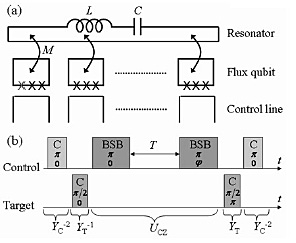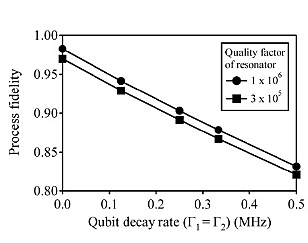Physical Science Laboratory, *National Institute of Informatics
Superconducting qubits have attracted increasing interest in the context
of quantum computing and quantum information processing [1]. We are focusing
on a superconducting flux qubit/resonator system [see Fig. 1(a)] where
the resonator works as a quantum bus (qubus). Using the qubus concept we
can perform any two-qubit operation between any two qubits that are coupled
to the quantum bus without using multiple swap gates, which are required
in other systems that use direct qubit-qubit coupling. We present an experimentally
realizable microwave pulse sequence that effects the controlled-NOT (C-NOT)
gate operation in a qubit/resonator system [2]. From numerical simulations,
we obtained a process fidelity FP [3] of 98.8 % (98.0 %) for a two-(three-)qubit/resonator system under
ideal conditions.
Figure 1(a) is a schematic of our system. Each qubit couples to the resonator
through a mutual inductance M. Because of the fixed coupling, the qubit transition frequency depends
slightly on the resonator state. We utilize this frequency difference to
realize the C-NOT gate in cooperation with a two-photon blue side band
(BSB) transition, which can create an entanglement between the control
qubit and the resonator. Figure 1(b) shows a basic operational sequence
of pulses on our two-qubit/resonator system. The pulse characteristics
are represented by a frequency (C: carrier frequency, BSB: BSB frequency),
a length (π/2, π) and a phase (0, π, φ) from the top to the bottom. We obtained an FP of 98.8 % by optimizing the free evolution time T and the phase of the
second BSB pulse φ. Here we set the frequencies of the control, target qubit and resonator
at 6, 5 and 10 GHz, respectively, and the coupling between the qubit and
the resonator at 0.1 GHz. Moreover, we obtained a high FP of 98.0 % even when we added a third qubit with a frequency of 7 GHz,
which means that our proposal is scalable. The total gate time is 200 ns,
which is much shorter than the coherence time of a flux qubit (4 µs).
We estimated FP under decoherence (see Fig. 2). We obtained an FP of 90.3 % under the best conditions yet achieved experimentally: Q=106 and Γ1=Γ2=0.25 MHz. Even with this realistic decoherence model, FP still exceeds 90 %, showing that our gate remains robust against this
type of loss.
This work was supported by KAKENHI.
[1] J. Clarke and F. K. Wilhelm, Nature 453 (2008) 1031.
[2] S. Saito, T. Tilma, S. J. Devitt, K. Nemoto, and K. Semba, Phys. Rev.
B 80 (2009) 224509.
[3] I. L. Chuang and M. A. Nielsen, J. Mod. Opt. 44 (1997) 2455.
 |
 |
|||||
|
|